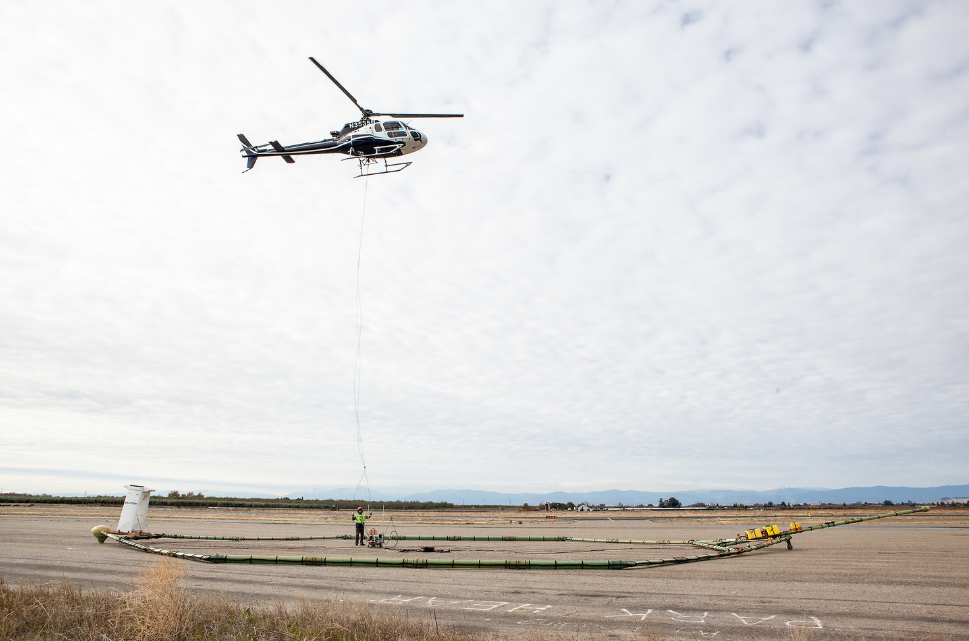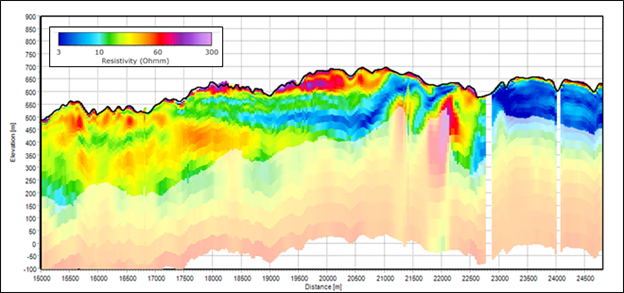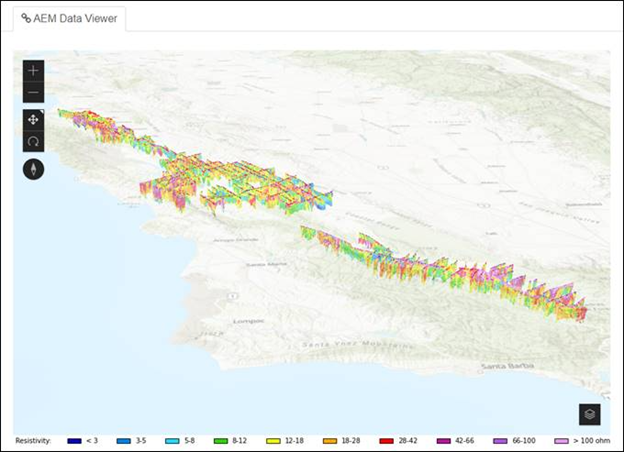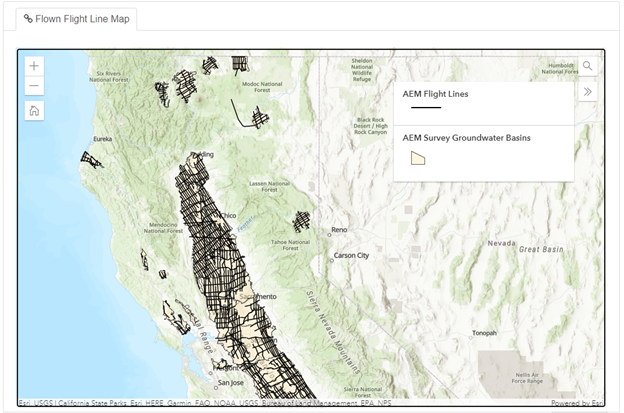Airborne Electromagnetic (AEM) Surveys

Flyover of a helicopter performing an Airborne Electromagnetic Survey.
The Department of Water Resource’s Basin Characterization Program provides the latest data and information about California’s groundwater basins to help local communities better understand their aquifer systems. One of the technical assistance projects under the Basin Characterization Program is DWR’s Statewide Airborne Electromagnetic (AEM) Surveys.
As a part of the AEM project, DWR is conducting AEM surveys in California’s high- and medium-priority groundwater basins, where data collection is feasible. The collected AEM data assists local water managers in characterizing their aquifer systems and supports the implementation of the Sustainable Groundwater Management Act (SGMA) to manage groundwater for long term sustainability.
The AEM project provides state and federal agencies, groundwater sustainability agencies (GSAs), stakeholders, and the public with basin-specific and cross-basin geophysical data, tools, and analyses.
The surveys are funded by voter-approved Proposition 68, Senate Bill 5, and from the general fund. More information can be found in the AEM Proposition 68 Fact Sheet.
During an AEM survey, a helicopter tows electronic equipment that sends signals into the ground which bounce back. The process has been compared to taking an MRI of the ground’s subsurface. The data collected is used to create continuous images that are interpreted for underground geology.
The resulting information will provide a standardized, statewide dataset that improves the understanding of aquifer structures. It can also help with the development or refinement of hydrogeologic conceptual models and can help identify areas for recharging groundwater.
AEM Survey Schedule
AEM surveys began in the summer of 2021 and will continue over the next several years. Visit the AEM Survey Schedule Storymap for up-to-date information on the current survey schedule and a map showing basins and their survey schedule status.
- AEM measures the electromagnetic response of the subsurface.
- AEM data are collected using geophysical instruments on a hoop that is towed beneath a helicopter.
- A current is generated in the hoop, which sends an electromagnetic signal into the subsurface. The response of the subsurface materials is measured in a receiver mounted on the helicopter.
- The measured response is related to the electromagnetic properties of the subsurface materials. Typically, materials that are electrically conductive are interpreted for fine-grained materials, like silts and clays, or can be interpreted for water with high salinity. Materials that are electrically resistive are interpreted for coarse-grained materials, like sands and gravels.
- The interpretation of AEM data is supported by information that describes the physical characteristics of the rocks. Existing information from well completion reports, electromagnetic geophysical (resistivity) logs, water quality reports and water level reports are used to do obtain this information.
- The AEM method can image the subsurface to depths of up to about 1,000 feet, depending on the electrical properties of the subsurface materials.
A conceptual diagram for how the electromagnetic method works

- AEM data will not be collected over residential areas and structures containing people or confined livestock.
- The helicopter is flown by an experienced and licensed pilot who follows all Federal Aviation Administration, state, county, and city laws and regulations.
- The helicopter flies at about 200 feet above ground and carries the instruments about 100 feet above the ground.
- The noise generated by the helicopter will be less than the noise generated from operating a leaf blower or lawn mower.
- The signal generated by the AEM equipment is comparable to the signal generated one foot away from a standard kitchen standing mixer.
AEM equipment setup and pre-flight preparation.

GSAs in high- and medium-priority groundwater basins do not need to reach out to DWR to request that surveys be conducted. After a basin has been scheduled to be surveyed, DWR will reach out to the GSA’s representative to schedule a meeting and request information (described below).
Survey Flight Lines
AEM data will be collected in a coarse grid with an approximately 2 by 8 mile spacing. DWR will determine the flight lines by considering local hydrogeology and important areas within each basin, including areas with known data gaps, areas adjacent to critical infrastructure, or areas where recharge is being considered. DWR will contact GSAs prior to flight line development to gather information about important areas within each basin.
Existing Data
GSAs are encouraged to provide relevant, existing data to DWR to support the interpretation of the AEM data. The following types of existing data are requested:
- Lithology logs
- Electrical resistivity logs
- Hydrogeologic conceptual models
- Groundwater models and texture data
More information about the data type, quality, and format requested by DWR can be found in the Existing Data Fact Sheet.
Fill out the Existing Data Point of Contact Form to receive an email providing access to DWR’s data upload platform through Box.com.

The data collected during the AEM surveys are expected to yield information about the condition of aquifers within a basin that will be beneficial to groundwater management efforts across an entire basin.
Because all data collected as a part of the survey will be available to the public, DWR has elected not to survey Tribal trust lands unless the Tribe within the surveyed basin indicates that data collection and publication is acceptable. DWR will engage with Tribes who have Tribal trust lands in medium- and high-priority groundwater basins through letters to Tribal leaders. Letters will include information about the project and an invitation to elect to join the surveys.
Note, data collection may not be possible over all Tribal trust land due to technical limitations. Technical limitations can be caused by the proximity of a potential survey area to urban areas, buildings, or electromagnetic noise sources, like infrastructure.
Visit the AEM Survey Schedule webpage for a map showing the locations of federally recognized Tribal trust lands and the AEM survey basins.
DWR will engage with Tribes who have Tribal trust lands in medium- and high-priority groundwater basins through letters to Tribal leaders. Letters will include information about the project and an invitation to elect to join the AEM survey project.
Tribes that wish to elect to join the AEM survey project or would like additional information should contact the AEM Project Manager at Katherine.Dlubac@water.ca.gov.

AEM Data Publication
All data collected as a part of the Statewide AEM Surveys will be made publicly available through the CaliforniaNatural Resources Agency Open Data Portal approximately six to twelve months after surveys are complete. Data will be provided as .csv or .xyz files and in other formats, as appropriate. Datasets that will be publicly available include:
- AEM Datasets: Raw, processed, inverted, and interpreted AEM data, as well as uncertainty analyses.
- Supporting Datasets: Digitized lithology and geophysical logs, water levels, total dissolved solid concentrations.

Example AEM data cross section showing the distribution of electrical resistivity values with depth
AEM Data Viewer
The AEM Data Viewer is an innovative tool that allows GSAs and stakeholders to view AEM data online. This GIS-based tool displays AEM data in a three-dimensional space and allows the user to interact with the data by zooming in and viewing the data from various angles. The tool can be accessed on a computer or mobile phone and does not require data to be downloaded or the use of specialized software
Pilot Studies
Three pilot studies were conducted in California to support the development of the AEM project in the Sacramento Valley in Colusa and Butte county groundwater basins; the Salinas Valley in Paso Robles groundwater basin; and in the Indian Wells Valley groundwater basin. Data collected provided foundational information about the aquifer systems in these areas which has been used to develop or refine the hydrogeological conceptual models for each area.
All pilot study reports and data are available on the California Natural Resources Agency Open Data Portal.

AEM Pilot survey flight lines in Butte and Glenn Counties
DWR's Public Outreach Materials
DWR Public Events
Public AEM Webinar June 8th, 2021
External Resources
The AEM method has been used for decades to map aquifer structures and support groundwater management, both nationally and internationally. The links below highlight programs that demonstrate both the state and international approach for collecting and utilizing AEM data.
United States
- Stanford Groundwater Architecture Project (GAP)/California AEM Pilot Studies
- United States Geological Survey, Mississippi Alluvial Plain (MAP) Regional Water Availability Study
- University of Nebraska - Lincoln, Nebraska GeoCloud
- State of Wisconsin, Department of Agriculture, Trade and Consumer Protection, AEM Survey
International
- GeoScience Australia Airborne Electromagnetic programs:
- Australia, New South Wales Government, MinEx Cooperative Research Center
- Hydrogeophysics Group, Aarhus University, Denmark
Contact Information
General Inquiries
AEM@water.ca.gov
Northern Region
Monique Gaido
Monique.Gaido@water.ca.gov
North Central Region
Chelsea Spier
Chelsea.Spier@water.ca.gov
South Central Region
Amanda Peisch-Derby
Amanda.Peisch@water.ca.gov
Southern Region
Jack Tung
Jack.Tung@water.ca.gov
DWR Headquarters
AEM Project Manager
Katherine Dlubac
Katherine.Dlubac@water.ca.gov


